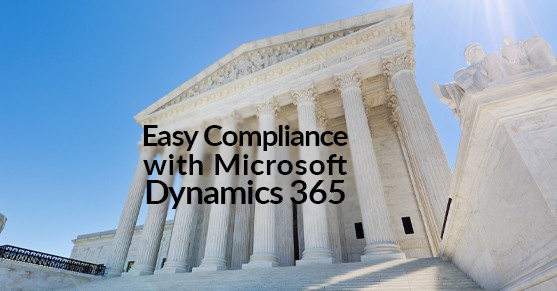When it comes to compliance for government contractors, there’s a lot you need to know. The rules and regulations for business systems set out by the Defense Contract Audit Agency (DCAA) and those established by the Defense Contract Management Agency (DCMA) for physical assets can be dense, to say the least. As intricate as the regulations may be, any system can be compliant.
What is DCAA and DCMA Compliance?
So what exactly do these two agencies look for? For DCAA, being compliant means adhering to the three major standards and guidelines: Cost Accounting Standards (CAS), Federal Acquisition Regulations (FAR), the Generally Accepted Government Accounting Standards (GAGAS). These standards outline how government contractors need to set up their system and contracts for accounting and cost reporting (pre- and post-award). Altogether, the regulations set by DCAA are intended to ensure that government contractors are financially stable enough to deliver appropriate services and complete contracts.
On the other hand, DCMA regulations focus on assets; that is, government contractors are required to maintain consistent (and accurate) identifications, labeling, tracking, and reporting of supplies, services, and that they all abide by the projected cost and timeline of the contract. Auditors systematically review these with a series of policies around asset (MIL-STD 130) and shipping (MIL-STD 129) identification. If audited, contractor systems must comply with DFARS 252.211-7003 (item identification), DFARS 252.211-7007 (reporting of government property), and FAR 52.245-1 (government property management).
What Compliance Looks Like
As it pertains to accounting system compliance, the pre-award survey SF 1408 laid out for a contractor the way to set up and operate your system to achieve compliance with DCAA. The top-level requirements are around having a logical and consistent method for keeping your books of record whether you are performing work for the Federal Government or a Commercial client. You need to have a Chart of Accounts that clearly segments Direct Cost from Indirect Cost, Allowable Cost from Unallowable cost as well as creating a structure to easily support, billing, reporting, and auditing.
These requirements can be achieved with a standard off the shelf accounting package with work often being done offline to support indirect rate allocations, invoicing for Cost Plus contracts and submitting your incurred cost submissions. As a government contractor grows in size, the risk profile for the Federal Government changes and DCAA expects these processes to be completed inside of a system that supports automation and transparency of these functions. This is the point when the Government urges the contractor to move to a more sophisticated system.
Microsoft Dynamics 365 for Compliance
There’s a lot to pour through in the details of each, but it’s nice to know that any system for accounting or asset management has the potential to comply with these mandates. Unfortunately, keeping a system compliant takes time. For years, simplistic systems like Quickbooks with Microsoft Excel could prove themselves worthy of these regulations. Administrators of government contractor systems would spend extraneous amounts of time making sure their input matched the requirements.
Today, there’s no time to spend on manually maintaining a compliant system. Accounting and asset management systems need to be highly effective and flexible to match the demands of modern government contracting. Thankfully, Microsoft Dynamics 365 presents itself as a formidable ERP solution to not only ensure compliance but do it without any excess work. Even better, with a trusted partner like XTIVIA, we can help your team automate functions in Microsoft Dynamics to maintain compliance efficiently and without errors.
Solutions for government contractors have required compliance requirements as well as a business process unique to when your main customer is the US Federal Government. Here’s how each facet of Microsoft Dynamics 365 has been tailored by XTIVIA to meet compliance regulations, and what XTIVIA can do to help.
Dynamics NAV & 365 Business (SMB)
- Indirect Rate Management
- DCAA Compliant Time & Expense Tracking
- Invoicing & Revenue Recognition
- Labor Distribution
- Incurred Cost Submission (ICE)
- Standard Government Forms (SF1034, 1035, DD250)
- Managing Contract Vehicles and IFF for GSA
- Standard reports and Dashboards for Operations and Finance
Dynamics 365 Enterprise
- Indirect Rate Management
- Invoicing & Revenue Recognition
- Labor Distribution
- Standard Government Forms (SF1034, 1035)
- Standard reports and Dashboards for Operations
Power BI (Business Intelligence Dashboards)
Financial Dashboards
- Indirect Rates
- Cash Flow Trending
- Trended Income Statement
Project Management Dashboards and Reporting
- Project Profitability
- Utilization
- Actual vs Budgeting and Forecasting
Dynamics 365 for Sales
- Sales Process following the Shipley Methodology
When companies decide they want to move from a more generic solution to one specifically for government contractors, they typically sacrifice flexibility and general capabilities for a product that’s uniquely designed for their industry. Microsoft Dynamics 365 is the best solution for a company that wants compliance out-of-the-box and doesn’t want to sacrifice technology, reporting, or flexibility.
XTIVIA has been focused on solutions for government contractors for almost 20 years. Our employees are experts in the industry, and they’re driven to help clients get the most value out of all of the Microsoft solution. Our tailored solutions are certified for Microsoft Dynamics and can be found on Microsoft AppSource or by contacting XTIVIA directly here. Come experience compliance plus a whole lot more with Microsoft Dynamics and XTIVIA.

